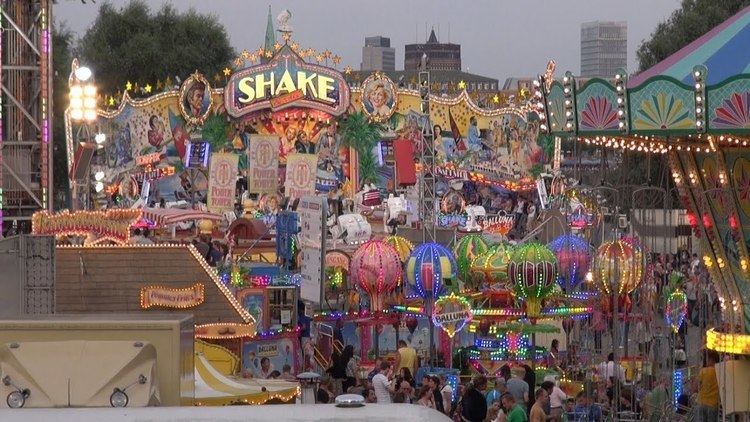 | ||
Similar Rheinwiesen, Cannstatter Volksfest, Hanover Schützenfest, Rheinturm, Palmkirmes Recklinghausen | ||
Largest fair on the rhine dusseldorf germany funfair
The Largest Fair on the Rhine (German: Größte Kirmes am Rhein) is a fair in Düsseldorf, drawing more than 4 million visitors annually, is one of Germany’s biggest fairs. It takes place the third week in July (2015 dates: July 17-26) on the left bank of the Rhine River, in the district Düsseldorf-Oberkassel, and features beer and food tents, amusement park rides, vendors, etc. as well as 10 days of various associated events and activities.
Contents
- Largest fair on the rhine dusseldorf germany funfair
- Gr te kirmes am rhein in d sseldorf 2016 largest fair on the rhine
- History
- Program
- References
Only three other German fairs get more visitors than Düsseldorf: Oktoberfest in Munich (6.7 million attendees in 2007), the Cranger Kirmes in Herne (4.5 million), and the Cannstatter Volksfest in Stuttgart (4.2 million).
Gr te kirmes am rhein in d sseldorf 2016 largest fair on the rhine
History
The Largest Fair on the Rhine has its roots in an annual celebration in honor of:
The celebration of both events took place first in 1435. At the time it was organized by the local St. Sebastianus shooting club around a traditional shooting competition (called Schützenfest – marksmen festival), a local annual tradition involving a wooden target on a pole, usually a representation of an eagle. In the 16th century, the fair was said to be an occasion for King Henry VIII” to introduce his future wife Anna van Kleve to the public.
In 1910, the fair was moved to its present location, the fairgrounds on the left Rhine river bank in Düsseldorf’s district Oberkassel overlooking the city’s historic Old Town. Since then, the format and focus of the fair have changed significantly into the more secular and entertainment-oriented event it is today. Attendee numbers rose dramatically, and the event was stretched into 9 days. The name of the event developed in the 1970 simply into “Largest Fair on the Rhine” and has stuck since then. It is not only Germany’s fourth-largest fair but also one of the most important events for Düsseldorf’s economy.
Program
The fair incorporates a number of events in a fixed sequence that reflects the historic format. Highlights include:
1:00 pm: Opening ceremony by Düsseldorf’s mayor followed by an evening drumbeat in front of Düsseldorf City Hall.
Morning mass in Old Town’s St Lambertus Church. At 4:00 pm, 3000 members of St. Sebastianus shooting club (called Marksmen’s Club) march through the city’s old town. In the evening, the club’s young members engage in a junior shooting competition on the fairgrounds.
Inauguration of the winner of the previous day’s junior competition as “king” for the year on the balcony of City Hall.
Another tradition developed strongly over the past 20 year: Pink Monday, now a gathering of 50,000 gays and lesbians on the fairgrounds, making Pink Monday the largest event in Düsseldorf for the gay and lesbian community.
7:00 pm: Senior shooting competition on the fairgrounds
Evening mass at St. Lambertus Church in Old Town, followed by a procession featuring the Appolinaris Shrine containing the patron saints’ remains.
Crowing of Tuesday’s winner of the senior competition, the marksmens’ “king”. 10:00 pm: fireworks on the Rhine.
2008 saw a modification of the traditional sequence of events in an effort to improve the fair: For the first time and as a trial run, the Marksmen’s Parade took place on Saturday, not Sunday, to coincide with the opening of the amusement park portion of the fair. The parade started at the fairgrounds and ended in Old Town.
